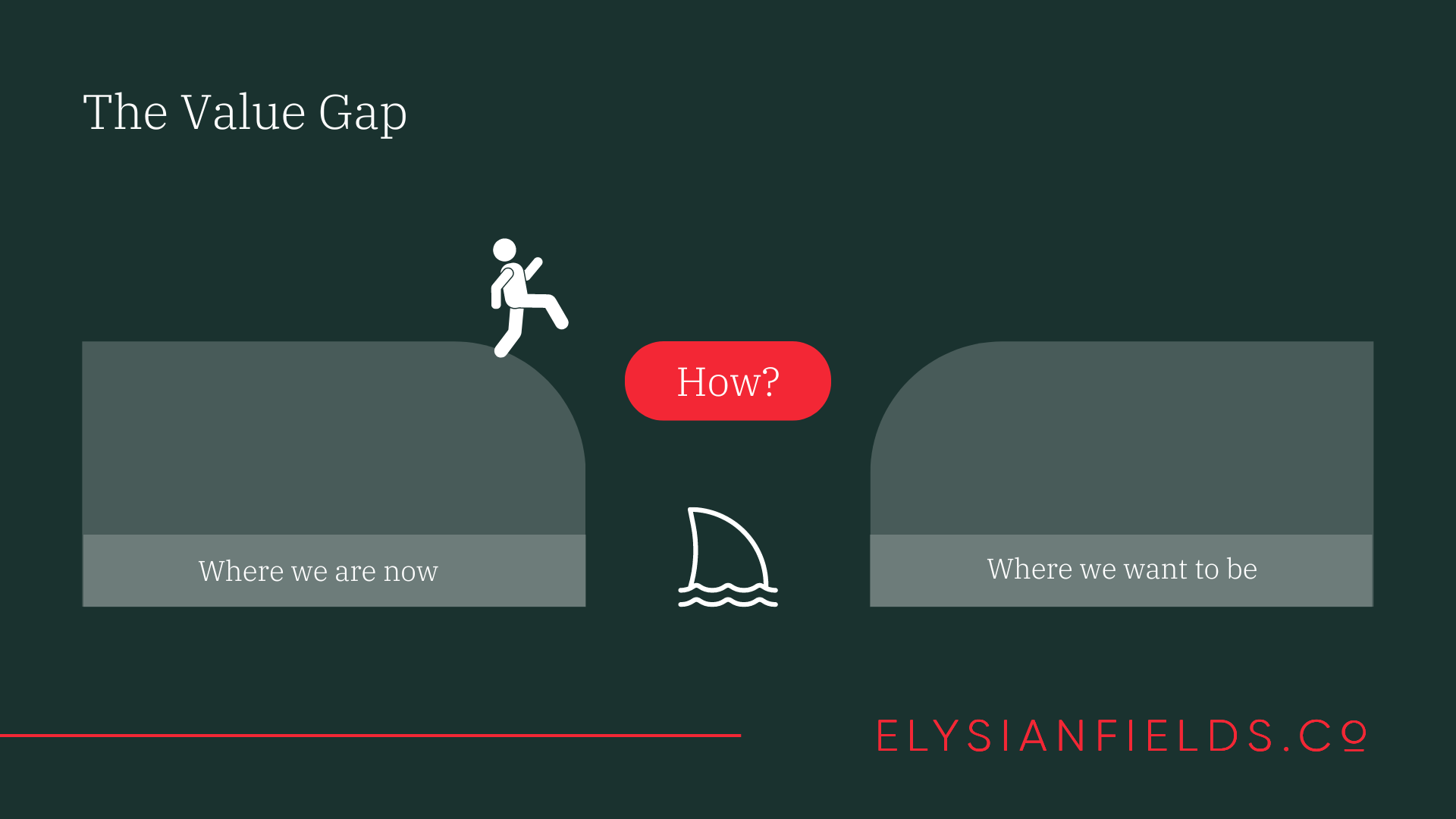What is ‘value’?
Obviously it depends on the buyer and their needs.
The word means ‘the regard that something is held to deserve’; the ‘importance, worth, or usefulness of something’. It’s from the Old French: valoir ‘be worth’ Latin: valere ‘be strong, be well, be worth, have power, be able.’ apparently.
So how are we of value to someone? We solve their problems, getting them from where they are to where they want to be as effectively and efficiently as possible.
Very often (but not always) value can be found in ‘how’ you get the buyer from A to B.
The buyer has goals (specific Jobs to be Done). They have plans for achieving them (hopefully). They are deploying workarounds to get their Jobs done. Or they are in the market looking at solutions already, sure of what the category offers. Critically, they may not buy any solution if cheaper workarounds can do the job.
So marketing needs to show how and why our widget is a better way to get their Job done than their workarounds or direct competitors.
Consequently, your value can’t be described as ‘easier’, ‘smarter’ or ‘better’. Because ‘easier’ or ‘better’ doesn’t get their Job done. These descriptions require the buyer to do all the thinking – to match your promise of ‘better’ with their own nuanced needs. UX expert Steve Krug famously advised website designers: “Don’t make me think”. Yet many marketing messages do just that – they force the buyer to work out how feature X can solve Job Y. This is dumb of marketers and unfair for buyers. It’s a case of square peg, round hole etc.
So we’re seeking a specific, relevant and urgent description of the value your widget offers buyers, not flabby words like ‘easier’ or better’.
We don’t want to make buyers think – we want to inspire them that we (and we alone) can get their Jobs done in a quick and risk free manner.
Your value is ‘how’
Most of the time your competitors will sell ‘what’: what they make, what it does, what it takes to use it, what it costs.
Since Simon Sinek, there will be lashings of ‘why’ too.
But neither ‘what’, nor ‘why’ solves buyer problems or gets their jobs done. So these should be used sparingly.
For example, let’s say a buyer’s Job to be Done is to increase spend from customers 3 fold.
The strategy could involve CRM systems, or chat bots, or outbound sales, or trips to the rugby.
Many chat bot or CRM platforms will talk about increasing revenue, and will promote the features of outbound email, automation and AI driven messaging. Those are the ‘what’ elements.
Yet the prospective buyer has a ‘how’ problem. The CRM or chat bot systems that talk about the pains of workflows, content sign offs, team processes and optimisation based on campaign performance will fair a lot better than those selling increased revenue. They are addressing the ‘how’ issues every user has. Solve the ‘how’ issues and you’re halfway there to building the trust buyers need to have in your services.
For example, we were on a customer research call for a Learning Management System client recently. The customer asked for features (‘what’) but these feature requests didn’t address their core Job to be Done – which was to align their team internally to get training courses created. The features were small incremental improvements to the core system. They wouldn’t impact the core problem – the workflows to getting training content created.
This is not an isolated challenge. Almost all our insight work points to questions around ‘how’ customers can get their Jobs done more easily and efficiently – using the vendor’s tool or not.
If this doesn’t happen Sales, Product and Marketing teams end up speaking a different language to buyers. Buyers universally struggle with processes and internal challenges. Vendors rarely solve for these issues, focusing instead on selling the big gains possible when the product is used without internal barriers.
Buyers know that already – these are the ‘what’ promises of the category.
All that buyers want to know is ‘how’ you’ll help them deliver on these promises, so they can decide if it’s worth switching from the workarounds they already use.
Here’s an example pitch:
[What]
The Elysian Fields Unfair Advantage Sprint aligns teams on what they should be saying to whom, when, how and why in order to deliver sustainable lead flow to your sales function.
[How = Value]
We do this through team workshops and interviews with customers and stakeholders. This process is guaranteed to deliver clarity: you get a market positioning, validated messaging for each stage of each segment’s decision journey and tested sales and marketing assets for your newly energised sellers. It’s fast, efficient and delivers validated Jobs to be Done insight for your product, marketing and sales plans.
[Urgency]
We only take on 2 clients a month, so please reserve your place as soon as you can. Let’s chat 😉
Want to learn more about Value Propositions? Watch Webinar #3 below

